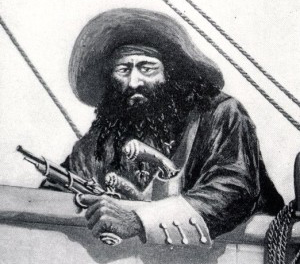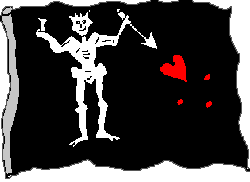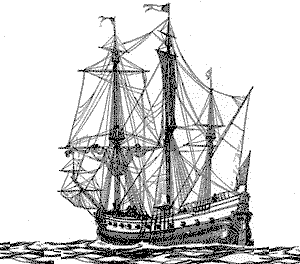Great Food • Fun • Grog
Blackbeard, the Pirate
BLACKBEARD, AKA EDWARD TEACH, Thatch or Drummond (depending on the researcher) was born around 1680 in Bristol, a British port town. "Edward Teach" is the most commonly accepted name. Little is known about the budding Blackbeard, but he could read and write, indicating that his family had money. Most pirate researchers believe his father was a privateer and that young Teach followed in his footsteps, launching his privateering "career" in Jamaica.
By the time Britain withdrew from the War in 1713, Teach had become quite adept at the art of pillaging and plundering. Like many other privateers, he found himself unemployed at the war's end. While some went home to do reputable things, Blackbeard joined with other wayward pirates in the Caribbean, roving the seas for bounty.
Teach's privateer license was revoked in short order and, by 1716, he found himself under the auspices of Captain Benjamin Homigold, who taught Blackbeard everything he knew.
LOYALTIES WERE HARD TO COME BY IN THE HIGH SEAS and Homigold was soon overthrown; Blackbeard was the newly elected captain. Favoring a French slave ship Homigold had captured, Blackbeard moved his crew and renamed her Queen Anne's Revenge. He obviously liked this ship, as he stayed with her for most of his swashbuckling hijinks on the seas, until he ran her aground. But that story comes later.

His very appearance was terrifying, giving him a tremendous psychological edge as he jumped aboard the seized ships. Blackbeard was a large, tall man with a booming voice, accented by an enormous black beard in which he embedded fuses, lighting them just before attacking. Just picturing such an image sends shivers up the spine!
These tactics served him well, as many crews surrendered before a shot was ever fired, watching helplessly as Blackbeard and his pirate underlings overtook their merchant ships and cargo, robbing any passengers while the ship was being looted. It was all fair game in Blackbeard's book.
BY MAY OF 1718, BLACKBEARD HAD MADE HIS WAY TO CHARLESTON, SOUTH CAROLINA, onboard Queen Anne's Revenge, along with three other small vessels he had stolen - and 700 men under his command. With his flagship and fleet of three, he blockaded merchant freighters as they were attempting to leave or enter the port.

For whatever reason, Blackbeard sank Queen Anne's Revenge soon after this blockade. Some say he did this purposely in an attempt to shed some of his crew and to boost his own share of the booty. The goods stolen from Charleston were moved to a smaller ship, "Adventure," which soon carried him to his death.
He proceeded to strip his treasure from three more ships, then ditched most of his crew by beaching or marooning them. It seems clear at this point that he had a plan. At the age of 38, he was ready to slow down a bit and enjoy the fruits of his looting.
He journeyed to Bath, North Carolina, to accept a pardon for his piratey ways under the Royal Act of Grace. At the time, North Carolina was still a British colony, so pardons could still be offered by King George I to pirates who chose to quit plundering.
NORTH CAROLINA GOVERNOR CHARLES EDEN was only too happy to grant Teach a pardon. Not only was Teach pardoned, but Eden then ordered the court to declare him a privateer. Eden had a plan: As a privateer, Teach could continue plundering ships in Carolina waters, as long as he was willing to share his loot with the governor! The governor's dubious actions convinced many citizens that he was in cahoots with Blackbeard.
However, Blackbeard seemed to be trying to clean up his act. Within weeks of his pardon, he began settling down, purchased a house in Bath, and married - for the 14th time. It's hard to imagine Blackbeard kicking back with a nice grog, playing house with his new bride, retired from the mayhem that defined him, so it's no surprise that his huge presence was disconcerting to a lot of people.
Governor Eden's culpability made it impossible for the citizens to appeal to him to rid themselves of Blackbeard, so they turned to Virginia's Governor Thomas Spotswood. Governor Spotswood hired a British Naval officer, Lieutenant Robert Maynard, to capture Blackbeard for a reward of £100, and smaller amounts allotted for his crew. With two sloops and about 55 men, Maynard set sail on his small vessels which boasted few guns, meaning most combat would be hand-to-hand with knives and swords Starting at the James River, it took 10 days to make their way to Blackbeard and his pardoned pirates, a crew of about 19, anchored in North Carolina's Ocracoke Inlet.
Noting the movement of the tide, wily Maynard waited for the right time to attack, planning an early morning surprise for Blackbeard and his hard-drinking crew. But Blackbeard, anticipating Maynard's attack, cut his anchor loose and moved his ship further inside the inlet to a smaller channel. Maynard's chase quickly landed his sloops in the mud.
By then, the ships were within shouting distance of one another, and shout they did. Pirate historian Captain Johnson described their blunt discourse: "Blackbeard hail'd him in this rude manner: 'Damn you for Villains, who are you? And from whence come you?' The Lieutenant make him Answer, 'You may see by our Colours we are no Pyrates.' Black-beard bid him send his Boat on Board, that he might see who he was but Mr. Maynard reply'd thus; 'I cannot spare my Boat, but I will come aboard of you as soon as I can, with my Sloop.' Upon this Blackbeard took a Glass of Liquor, and drank to him with these Words: 'Damnation seize my Soul if I give you Quarters, or take any from you.' In Answer to which, Mr. Maynard told him, that he expected no Quarters from him, nor should he give him any."
AND THE BATTLED ENSUED. When the sloops were freed, Maynard directed his men toward Blackbeard, albeit slowly by rowing because there was no wind in their sails. Blackbeard, using a technique he had perfected, broadsided the smaller of Maynard's two sloops and killed the captain; six others were killed and 10 wounded. Undeterred, Maynard continued his pursuit, finally forcing Adventure ashore.
Once again Maynard outmaneuvered Blackbeard, ordering his men to hide below in the holds. When the ships were broadside, Blackbeard and gang saw only the empty decks and made the fatal assumption that Maynard and his men were dead. They boarded the sloop.
Maynard's men suddenly emerged and a fierce battle began. It would be Blackbeard's last stand. Captain Johnson's history states that he (Blackbeard) stood his ground and fought with great fury till he received five and twenty wounds.
After Blackbeard bled to death, Lt. Maynard ordered his head cut off and the body thrown overboard Blackbeard's head was tied to the bowsprit of the Adventure and taken back to Virginia. Thus ended "The Golden Age of Piracy."
A year later, The Boston News Letter carried the following story about the deadly battle between Maynard and Blackbeard: "Maynard and Teach themselves began the fight with their swords, Maynard making a thrust, the point of his sword against Teach's cartridge box, and bent it to the hilt. Teach broke the guard of it, and wounded Maynard's fingers but did not disable him, whereupon he jumped back and threw away his sword and fired his pistol which wounded Teach. Abraham Demelt struck in between them with his sword and cut Teach's face; in the interim both companies engaged in Maynard's sloop. Later during the battle, while Teach was loading his pistol he finally died from blood loss. Maynard then cut off his head and hung it from his bow."
BLACKBEARD WAS A LEGEND IN HIS OWN TIME, so it's not surprising that legends soon surfaced about his death. Perhaps the most popular story centered on how his headless body swam around the Adventure several times before finally sinking.
After Maynard reached home, Blackbeard's head in tow, the infamous head was placed on a pike at the north shore of the Hampton River in Virginia. The place, now called Blackbeard's Point, serves as a reminder of what can happen to those who dare take up piracy.

